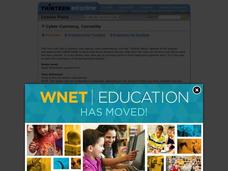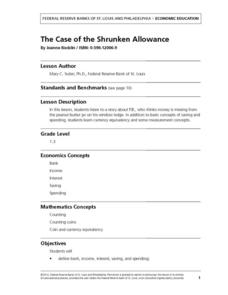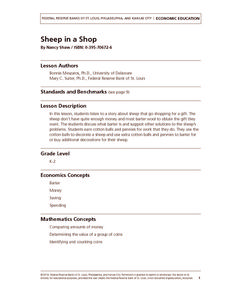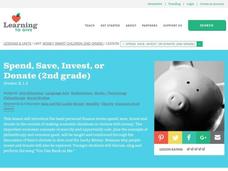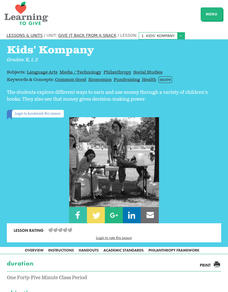Curated OER
The Bernstein Bear's Trouble with Money: Financial and Academic Literacy
What do figures of speech have to do with financial literacy? Take an interdisciplinary look at The Berenstain Bears' Trouble with Money to find out. Young analysts read about the cubs' spendthrift ways and how Mama and Papa Bear...
Curated OER
Short-Term and Long-Term Savings Goals
Fifth graders discover how saving money can apply to their lives. In this personal finance instructional activity, 5th graders use the book The Leaves in October, as a conversation starter on income, savings and setting goals. Students...
Curated OER
Cyber Currency, Currently
Students explore the value of currency and how to save and earn interest. In a key lesson, kids even get to purchase items in their classroom's general store. It's a fun way to learn the importance of being financially literate!
Curated OER
Savings and Earnings
Fifth graders complete several activities to learn about earning, budgeting, and saving money. In this saving money lesson, 5th graders read a book about saving money and complete a 'Savings and Earnings' worksheet. Students work in...
Curated OER
Thinking About Money
Students evaluate various approaches to spending money.In this spending money literacy lesson, students broaden their financial goals by reading "Alexander Who Used to Be Rich Last Sunday" and "A Chair for My Mother."Students use a Venn...
Federal Reserve Bank
The Case of the Shrunken Allowance
An allowance is an important thing! Make sure your kids know how to save and spend their own money. Using the book The Case of the Shrunken Allowance as a starting point, this plan covers income, spending and saving, counting, and more.
K12 Reader
Money, Money, Everywhere!
Pennies, nickels, dimes, quarters, half-dollars, dollars. Here's a comprehension worksheet that asks young readers to respond to a series of questions based on a passage about money.
Federal Reserve Bank
Sheep in a Shop
What do you think sheep might be able to barter when they don't have quite enough to buy a gift? Your pupils can find out this and much more during this lesson about Sheep in a Shop, spending, saving, and bartering.
Curated OER
Show And Tell
Have you ever saved your money to buy something you really wanted? Elementary schoolers share how they saved their money for things they wanted, and they bring in one or two items that they bought with their personal savings.
Curated OER
Money Vocabulary
In this money worksheet, learners look at 5 pictures and name each one, walk around the room find somebody that fits 6 scenarios and match 10 verbs in bold print with their appropriate phrases in grey.
Reed Novel Studies
Lawn Boy: Novel Study
A mountain of grass becomes a mountain of cash in the case of a young entrepreneur in the novel Lawn Boy. Arnold, a main character, begins a lawn mowing business and meets a stockbroker client that helps me manage his money....
Curated OER
Money Smart children
Students elementary financial vocabulary words: spend, save, invest and donate. In this finance lesson, students respond to the story "Sam and the Lucky Moon." Students describe the concepts of wants and needs, resources, scarcity,...
Curated OER
Money and Business (Art)
Third graders investigate world currency by creating their own coin art. In this government lesson, 3rd graders examine the characteristics of different coins and create their own design for a new one. Students discuss and...
Curated OER
Earning a buck? and stretching it?
Students write a feature article and create a visual display explaining how teens can save or invest their money wisely. They research ways to earn interest in today's economy, even if you don't have much money. Students use Internet...
Curated OER
Vocabulary Lesson: Money Worksheet
In this money vocabulary worksheet, students answer 10 short answer questions about spending and saving money. Students must write about borrowing and lending money as part of this worksheet.
Curated OER
Using Credit: Not for a Billion Gazillion Dollars
Fifth graders explore the concept of credit. In this consumer education lesson, the teacher uses the book Not for a Billion Gazillion Dollars to lead the class in a discussion about credit, debit, and income. Students then analyze their...
Curated OER
Saving Strawberry Farm
Students explore U.S. History by analyzing the Great Depression. In this economic instability lesson, students read fictitious accounts of a farm dealing with the loss of a Strawberry Farm and discuss the reasons behind the loss....
Curated OER
Thinking About Money
Young scholars explore the concept of a personal budget. In this philanthropy lesson, students use a Venn diagram to compare 2 stories in which the main characters spend money in different ways.
Curated OER
Idioms Quiz: Money 3
In this English idioms worksheet, students interpret the meaning of phrases having to do with money. Students complete sentences using the meanings of the phrases.
Curated OER
Stone Fox and Economics
Pupils read the novel Stone Fox and review economic concepts including income, goods, and services. They define the following terms: capital, credit, credit risk and summarize their reading by reading several chapters at a time. They...
Curated OER
Give It Back From a Snack Lesson 1: Kids' Kompany
Students examine the ways to earn money and discover the different uses for money. They read children's literature and draw pictures of uses for money that benefit the common good.
Teach-nology
Making My Swimming Pool
If you'd always wanted an expensive swimming pool, how would you make the money to build it? Kids read a short passage about a quest to create a dream swimming pool, and use a list of words to fill in eight spaces throughout the...
Curated OER
Journal Entry: What You Want To Buy!
Third graders write a one page paper about what they would like to purchase given the savings techniques. They write down what the object is that they are going to buy, how they are going to earn money to purchase this object, and what...
Curated OER
Because of Winn Dixie Activity
In this Because of Winn Dixie worksheet, 4th graders use characters from the story to complete a problem solving activity. Students must determine which items to buy and how to earn the money for those items. There are five different...


